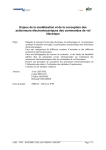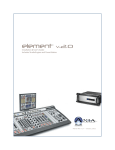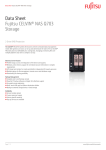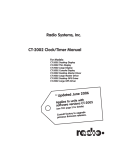Download Radio Systems Millenium-A Analog Console Operating instructions
Transcript
Radio Systems Millenium Digital Console Livewire® Model Additional Operating Instructions 601 Heron Drive • Logan Township, NJ 08085 Phone: 856-467-8000 • Fax: 856-467-3044 www.radiosystems.com Page 2 Radio Systems Millenium-D Livewire Console Radio Systems Millenium-D Livewire® Console Installation and Operation Manual Radio Systems Millenium Digital- Livewire® Broadcast Manual — Part # MAN-MILLCONLIV Manual Revision 02-29-2012 for serial numbers 100859 and higher Utilizing Millenium Livewire Digital Console Software V1.3.1.1 New features and modifications in Millenium Livewire version 1.3.1.1 1. Multiple GPIO Livewire profiles supported. 2. Source locking - source name flashes to indicate that it is in use on another Livewire source. Flashing clears when other user de-selects the source. 3. Iprobe - IP address is now recognized and displayed by Axia “Iprobe” program 4. Scenes a new scene source selection is not loaded (only) onto channels that are on. If the channel is on, the new scene source (if there is a new source for that channel as part of the new scene) will be displayed on the lower LCD line and the ON button will flash. Then when that channel is turned off, the scene will load. 5. IP/SUBMASK addresses display and change - IP AND submask addresses are now displayed and can be changed by holding the last rotary encoder knob down for 10 seconds. Table of Contents Livewire Control Board Parts Layout................................................................................. 3 Screen Shots................................................................................................................... 4-13 Creating backstreams (Mix-minus configurations)......................................................... 14 Remote Control - Overview Instructions.......................................................................... 15 Remote Control - GPIO Profiles................................................................................... 16-18 Remote Control - Wiring Diagram..................................................................................... 19 Password Reset Instructions............................................................................................ 20 Copyright 2012 by Radio Systems Design, Inc. All rights reserved. Radio Systems Design, Inc. reserves specification privileges. Information in this manual is subject to change without notice. Technical support: +1-856-467-8000 or [email protected] OUTPUT GROUNDING JUMPERS JU1 JU2 JU3 JU4 JU5 JU6 JU7 JU8 JU9 JU10 IN Analog Output 7 Analog Output 8 JU39 JU40 J1-J10 Connect left and center pins for inside ground Connect center and right pins for chasis ground (See Manual for Grounding Instructions) JU26 JU38 JU25 JU37 Analog Input 8 JU24 JU36 JU23 JU35 Analog Input 7 JU22 JU34 JU21 JU33 Analog Input 6 JU20 JU19 JU32 Analog Input 5 JU18 JU31 Analog Input 4 JU17 JU30 JU16 JU29 Analog Input 3 JU15 7L JU28 JU14 JU27 Analog Input 2 JU13 JU12 JU11 J1, J2, J3 Analog Input 1 J1-J10 JU41 JU42 ANALOG INPUT MONO/STEREO JUMPERS 8R 7R 8L Analog Output Levels Connect upper pins on both jumpers under each channel’s RJ-45 for stereo (factory default) JU11/12 thru JU25/26 Connect lower pins on both jumpers under each channel’s RJ-45 for mono JU11/12 thru JU25/26 GPIO Connector ANALOG INPUT GAIN JUMPERS From 8 position selector outputs 5-8 Connect no pins for unity gain Digital Output 7 From 8 position selector outputs 1-4 JU43 Digital Output 8 JU44 Digital Digital Input 1 JU45 Digital Input 2 JU46 Digital Input 3 JU47 Digital Input 4 Digital Input 5 JU48 JU49 Digital Input 6 JU50 Digital Input 7 JU51 Digital Input 8 Connect left and center pins for +20dB gain Connect center and right pins for +10dB gain DIGITAL INPUT GROUNDING JUMPERS JU52 JU43 thru JU52 JU43 thru JU52 IN JU53 Activity Connectivity (Yellow) (Green) Parallel Digital Output 1 JU54 Parallel Digital Output 2 JU55 Parallel Digital Output 3 JU56 JU57 Parallel Digital Output 4 Parallel Digital Output 5 JU58 Parallel Digital Output 6 JU59 Parallel Digital Output 7 JU60 Parallel Digital Output 8 Connect upper pins for inside ground Connect lower pins for chasis ground (See Manual for Grounding Instructions) DIGITAL OUTPUT GROUNDING JUMPERS JU53 thru JU60 JU53 thru JU60 IN Connect lower pins for inside ground Livewire Connect upper pins for chasis ground (See Manual for Grounding Instructions) 100 BaseT Analog Grounds JU61 (Jumpers Factory Set) (Jumpers Factory Set) JU62 JU63 JU64 Factory Programming (Jumpers Factory Set) RS232 (Factory Use) To Upper LiveWire Control Board Power, Mute, Timer Signalling to Output Board JU65 JU66 RS232 (Factory Use) DSP Data & Clocks to Output Board +5v from Power Supply MILLENIUM LIVEWIRE CONTROL BOARD Part # 16144 Radio Systems Millenium-D Livewire Console 1.0 Millenium Source Profile Properties Define, allocate to various faders and label sources (Axia inputs to the Millenium Livewire Console). 1.1 Setting Up 2-Way (mix-minus) source profiles 2.0 Millenium Scene Properties Name and define up to 8 front panel selectable scene presets (and startup default “scene”). 3.0 Console Outputs (Livewire Sources) Name, define and label destinations (Millenium Livewire Console outputs to Axia Livewire). 4.0 Console Inputs (Livewire Destinations) Select and label sources (Axia inputs to the Millenium Livewire Console). 5.0 Remote Control (GPIO) - 2 screens 5.1 GPIO Overview and Setup Instructions 5.2 GPIO Wiring and Pin-Out Diagram 6.0 Livewire I/O Meters Level test meters and input gain trims for all sources and destinations. 7.0 Livewire / QoS Quality of service parameter selections. 8.0 System IP, password, and software update options. 9.0 Console Node Parts Layout for Physical Connector Locations Page 4 Page 5 Radio Systems Millenium-D Livewire Console Millenium Source Profile Properties Define and allocate to various faders and label sources (Axia inputs to the Millenium Livewire Console) Radio Systems Millenium-D Livewire Console Millenium Scene Properties Name and define up to 8 front panel selectable scene presets (and startup default “scene”) Page 6 Radio Systems Millenium-D Livewire Console Console Outputs (Livewire Sources) Name, define and label destinations (Millenium Livewire Console outputs to Axia Livewire) Page 7 Radio Systems Millenium-D Livewire Console Console Inputs (Livewire Destinations) Select and label sources (Axia inputs to the Millenium Livewire Consoles) Page 8 Page 9 Radio Systems Millenium-D Livewire Console GPI Channel Assignment Select 1-8 Livewire sources that you wish to control (start/stop) or to control (turn on/off) console channels. Consult details on page 19 Page 10 Radio Systems Millenium-D Livewire Console GPI Pin Assignments For each (of eight) GPIO control sources, use this sub-screen to map up to five input and five output physical pins on the RJ-21 GPIO connector. Note that pins can be multiply assigned to different GPIO ins and outs, but that this is not recommended. Consult details on page 19. Page 11 Radio Systems Millenium-D Livewire Console Livewire / QoS Quality of service parameter selections Page 12 Radio Systems Millenium-D Livewire Console Livewire I/O Meters Level test meters and input gain trims for all sources and destinations Page 13 Radio Systems Millenium-D Livewire Console System IP, password, and software update options Note: Default username is “user,” default password is “user.” See last page of manual for password reset in case of forgotten password. Page 14 Radio Systems Millenium-D Livewire Console Millenium - Livewire Console Software Creating Backstreams (Mix-Minus feeds for 2-way devices) Gaining Perspective A Millenium output is a Source (input) to Livewire. A Millenium input is a Destination (output) of Livewire. Nomenclature assumes the Livewire network as the point of reference, so; A Livewire Destination is an Input to the Millenium Console. A Livewire Source is an output from the Millenium Console. Connecting the Two-Way Devices On the source node’s browser page, set a unique Axia channel number (for example, “1021”, where 102 is the last 3 digits of the node’s IP address, and 1 represents the physical port into which the device is connected). Define the Source Properties in the Millenium Browser Check all applicable boxes, including ENABLING the Backwards Feed check box. Select Backstream Mode In the Millenium browser Console Output section, set one of the outputs (from Outputs 3-8 - Outputs 1 and 2 are reserved) in the Backstream (Mix-Minus) Stream Mode. Ensure that the faders chosen have source “1021” (for example) available on the Source Profile Menu. Connect the Two-Way Devices’ Input to a Destination Node On the destination node’s browser page (ie. feeding the codec’s mix-minus), click on the Destination page, then change Type to “To Source” on the channel whose physical destination is the codec’s mix-minus. Put “1021”(for example) in the Channel Number field. Confirm Selection As a visual verification, when the codec is selected on a Millenum fader, two dots will appear above the Destination Node’s corresponding output channel. Utility Bus Programming Using the Millenium Console Utility Bus setup screen, create the appropriate mix minuses for Utility Bus 1-6. Millenium console outputs (Sources to Livewire) are factory default configured as: Livewire - Input #1 from Console Program Output* Livewire - Input #2 from Console Audition Output* Livewire - Input #3 from Console Utility Output #1* Livewire - Input #4 from Console Utility Output #6* Livewire - Input #5 from Console Utility Output #2* Livewire - Input #6 from Console Utility Output #7* Livewire - Input #7 from Console Utility Output #3* Livewire - Input #8 from Console Utility Output #8** Note: All outputs have been factory hard-wired between the console digital output board and Livewire input board as shown. The 6 utility outputs have been factory configured as mix-minus outputs so that program is sent “minus” that channels program audio is sent. E.G. -Utility output #1 is configured to be program (A or B input / post on-off switch post fader / mono mix) minus the program output of the first Livewire fader. Radio Systems Millenium-D Livewire Console Page 15 Remote Control - “GPIO” Interface Overview The Millenium Axia internal console node features a GPIO connector with 16 inputs and 16 outputs. Via programming these inputs and outputs can be assigned to any network audio source. In this way, the Millenium Livewire console channel can exercise start/stop control or a device can turn a Millenium console channel on and off when selected as a source on the LCD display above that fader. Physical Connectivity All GPIO inputs and outputs are located on the on-board RJ-21 50-pin male connector. Inputs are opto-isolated and are activated by being “pulled low” (connected to ground). Outputs are open collector and provide a path to ground when activated. Consult the Illustration on the following page for RJ-21 pin-outs and wiring illustrations Assigning GPIO via software set-up screens Source Configuration An existing audio source connected to the Millenium console or any Livewire node must first be set for GPIO control. On the source profile screen, select BOTH the appropriate GPIO profile and GPIO enable radio button. The GPIO source profile automatically sets up to 5 GPIO input and output functions for each source. These functions are listed in Illustration XXX on the following page. GPIO Channel assignment The Millenium console provided 8 GPIO “ports”, thus allowing up to 8 devices (Livewire audio sources) to have GPIO connectivity. These devices must be assigned as GPIO channel 1-8 on the Livewire GPIO port assignment GPIO Pin Mapping Source GPIO inputs and outputs (up to 5 of each for each source) must be “mapped” to the physical pins on the GPIO connector. This is accomplished on the GPIO “Pin Mapping” page accessed by clicking the “program pins” link alongside each Livewire GPIO port channel selection. For each active port channel assign an input or output GPIO pin by clicking the adjacent radio box. For example: If GPIO channel #1 is assigned to a CD player and that CD player’s start control is wired to GPIO port physical output pin#1 and the CD player’s EOM relay is wired to GPIO port physical input #1. Mapping Livewire port 1 / output pin#1 to GPIO output pin#1 and selecting this CD player on a Livewire console channel will cause the CD player to start when the CD’s console channel is turned on. Mapping Livewire port 1 / input pin#1 to GPIO input pin#1 and selecting this CD player on a Livewire console channel will cause the console channel to turn off when the CD’s EOM relay fires Livewire Console Remote Profiles There are 6 available preconfigured remote profiles. You must choose the appropriate profile when configuring Livewire Remote Control. The profiles available are below and are detailed on the following pages. Operator Producer Control Room Guest Studio Guest Line Computer Player Page 16 Radio Systems Millenium-D Livewire Console GPIO Operator’s Microphone Logic Name Pin Type Notes INPUTS ON Command IN-1 Active Low Input Turns channel ON OFF Command IN-2 Active Low Input Turns channel OFF TALK (to Monitor 2) Command IN-3 Active Low Input Activates the Element TALK to MON2 function and routes mic audio to the Talkback bus MUTE Command Mutes channel outputs IN-4 Active Low Input TALK (to PREVIEWED SOURCE) IN-5 Active Low Input Command Activates the TALK button on every source currently in preview and routes mic audio to the Talkback bus OUTPUTS ON Lamp OUT-1 Open Collector to Logic Common Return Illuminates when the channel is ON unless TALK or MUTE is active OFF Lamp OUT-2 Open Collector to Logic Common Return Illuminates when channel is OFF TALK (to Monitor 2) Lamp OUT-3 Open Collector to Logic Common Return Illuminates when TALK TO MON2 is active MUTE Lamp OUT-4 Open Collector to Logic Common Return Illuminates when MUTE is active TALK (to PREVIEWED SOURCE) OUT-5 Open Collector to Logic Common Return Illuminates when TALK to Lamp PREVIEWED SOURCE is active GPIO Producer’s Microphone Logic Name Pin Type Notes INPUTS ON Command IN-1 Active Low Input Turns channel ON OFF Command IN-2 Active Low Input Turns channel OFF TALK (to Monitor 2) Command IN-3 Active Low Input Activates the Element TALK to MON2 function and routes mic audio to the Talkback bus MUTE Command Mutes channel outputs IN-4 Active Low Input TALK (to PREVIEWED SOURCE) IN-5 Active Low Input Command Activates the TALK button on every source currently in preview and routes mic audio to the Talkback bus OUTPUTS ON Lamp OUT-1 Open Collector to Logic Common Return Illuminates when the channel is ON unless TALK or MUTE is active OFF Lamp OUT-2 Open Collector to Logic Common Return Illuminates when channel is OFF TALK (to Monitor 2) Lamp OUT-3 Open Collector to Logic Common Return Illuminates when TALK TO MON2 is active MUTE Lamp OUT-4 Open Collector to Logic Common Return Illuminates when MUTE is active TALK (to PREVIEWED SOURCE)OUT-5 Open Collector to Logic Lamp Common Return Illuminates when TALK to PREVIEWED SOURCE is active Page 17 Radio Systems Millenium-D Livewire Console GPIO Control Room Guest Microphone Logic Name Pin Type Notes INPUTS ON Command IN-1 Active Low Input Turns channel ON OFF Command IN-2 Active Low Input Turns channel OFF TALK (to CR) Command IN-3 Active Low Input Mutes channel outputs and routes source audio to PVW speakers MUTE Command Mutes channel outputs IN-4 Active Low Input TALK (to SOURCE) Command IN-5 Active Low Input Activates the TALK button on every source currently in preview and routes mic audio to the Talkback bus OUTPUTS ON Lamp OUT-1 Open Collector to Logic Common Return Illuminates when the channel is ON unless TALK or MUTE is active OFF Lamp OUT-2 Open Collector to Logic Common Return Illuminates when channel is OFF TALK (to CR) Lamp OUT-3 Open Collector to Logic Common Return Illuminates when TALK is active MUTE Lamp OUT-4 Open Collector to Logic Common Return Illuminates when MUTE is active TALK (to SOURCE) Lamp OUT-5 Open Collector to Logic Common Return Illuminates when the channel TALK To SOURCE function is active (Element only; Smart Surface not used) GPIO Studio (Monitor 2) Guest Microphone Logic Name Pin Type Notes INPUTS ON Command IN-1 Active Low Input Turns channel ON OFF Command IN-2 Active Low Input Turns channel OFF TALK (to CR) Command IN-3 Active Low Input Mutes channel outputs and routes source audio to PVW speakers MUTE Command Mutes channel outputs IN-4 Active Low Input TALK (to SOURCE) Command IN-5 Active Low Input Allows an external button to active channel TALK TO SOURCE FUNCTION. (Element only; SmartSurface not used) OUTPUTS ON Lamp OUT-1 Open Collector to Logic Common Return Illuminates when the channel is ON unless TALK or MUTE is active OFF Lamp OUT-2 Open Collector to Logic Common Return Illuminates when channel is OFF TALK (to CR) Lamp OUT-3 Open Collector to Logic Common Return Illuminates when TALK is active MUTE Lamp OUT-4 Open Collector to Logic Common Return Illuminates when MUTE is active TALK (to SOURCE) Lamp OUT-5 Open Collector to Logic Illuminates when the channel TALK TO SOURCE function is active (Element only; Smart Surface not used) Page 18 Radio Systems Millenium-D Livewire Console GPIO Line Input Logic Name Pin Type Notes INPUTS ON Command IN-1 Active Low Input Turns channel ON OFF Command IN-2 Active Low Input Turns channel OFF & sends 100 msec STOP pulse PREVIEW Command Turns preview ON IN-3 Active Low Input RESET Command IN-4 Active Low Input “Turns channel OFF, while not sending a STOP pulse” READY Command IN-5 Active Low Input Illuminates OFF lamp to indicate source’s readiness OUTPUTS ON Lamp OUT-1 Open Collector to Logic Common Return Illuminates when channel is ON OFF Lamp OUT-2 Open Collector to Logic Common Return Illuminates when channel is OFF and READY is active PREVIEW Lamp OUT-3 Open Collector to Logic Common Return Illuminates when PREVIEW is ON START Pulse OUT-4 Open Collector to Logic Common Return A 100 msec pulse when the channel status changes from OFF to ON STOP Pulse OUT-5 Open Collector to Logic Common Return A 100 msec pulse when the channel status changes from ON to OFF GPIO Computer Playback Logic Name Pin Type Notes INPUTS ON Command IN-1 Active Low Input Turns channel ON OFF Command IN-2 Active Low Input STOP pulse Turns channel OFF & sends 100 msec PREVIEW Command Turns preview ON IN-3 Active Low Input Not Used IN-4 Active Low Input “Turns channel OFF, while not sending a STOP pulse” READY Command IN-5 Active Low Input Illuminates OFF lamp to indicate source’s readiness OUTPUTS NEXT Pulse OUT-1 Open Collector to Logic Common Return A 100 mS PULSE sent when ON button is depressed except when initially turned ON OFF Lamp OUT-2 Open Collector to Logic Common Return Illuminates when channel is OFF and READY is active PREVIEW Lamp OUT-3 Open Collector to Logic Common Return Illuminates when PREVIEW is ON START Pulse OUT-4 Open Collector to Logic Common Return A 100 mS PULSE sent when channel is first turned ON STOP Pulse OUT-5 Open Collector to Logic Common Return A 100 mS PULSE sent when channel is first turned OFF Page 19 Radio Systems Millenium-D Livewire Console Millenium Livewire Console Output Wiring “GPIO” Wiring Pin-Out (controlGPI signals from the console) 680 Ohms 1 2 3 4 5 6 7 8 9 10 11 12 13 14 15 16 17 18 19 20 21 22 23 24 25 26 27 28 29 30 31 32 33 34 35 36 37 38 39 40 41 42 43 44 45 46 47 48 49 50 Output #1 Output #2 Output #3 Output #4 Output #5 Output #6 Output #7 Output #8 Output #9 Output #10 Output #11 Output #12 Output #13 Output #14 Output #15 Output #16 Input #1 Input #2 Input #3 Input #4 Input #5 Input #6 Input #7 Input #8 Input #9 Input #10 Input #11 Input #12 Input #13 Input #14 Input #15 Input #16 Ground Ground Ground Ground Ground Ground Ground Ground Ground Ground Ground Ground Ground Ground Ground Ground +15 Volts +15 Volts Remote start of source with open collector or opto-isolated (push-low) input terminal GPI Input Wiring (control signals to the console) n.o. switch Remote signaling from source with open collector or opto-isolated (pull-to-ground) output terminal LED Use of 66B punch block with integrated RJ-21 female connector is recommended. Specify RS Part #11616 with companion RS Part #RJ21RC-010 10' RJ-21 male to male 25-pair cable. 50-Pin internal console node “GPIO” connector 25 1 50 26 16 Inputs - Pull to Ground Input #1 - Pin 34 Input #2 - Pin 9 Input #3 - Pin 35 Input #4 - Pin 10 Input #5 - Pin 36 Input #6 - Pin 11 Input #7 - Pin 37 Input #8 - Pin 12 Input #9 - Pin 38 Input #10 - Pin 13 Input #11 - Pin 39 Input #12 - Pin 14 Input #13 - Pin 40 Input #14 - Pin 15 Input #15 - Pin 41 Input #16 - Pin 16 16 Outputs - Open Collector Output #1 - Pin 26 Output #2 - Pin 1 Output #3 - Pin 27 Output #4 - Pin 2 Output #5 - Pin 28 Output #6 - Pin 3 Output #7 - Pin 29 Output #8 - Pin 4 Output #9 - Pin 30 Output #10 - Pin 5 Output #11 - Pin 31 Output #12 - Pin 6 Output #13 - Pin 32 Output #14 - Pin 7 Output #15 - Pin 33 Output #16 - Pin 8 GND Pins 17, 18, 19, 20, 21, 22, 23 ,24, 42, 43, 44, 45, 46, 47, 48, 49 +15 Volts Pins 25, 50 (each is individually current limited) Page 20 Radio Systems Millenium-D Livewire Console Password Reset for Livewire Browser Screens Millenium Network Console Password Reset for Livewire Browser Screens • Locate the gray Millenium RS-232 adapter shipped with your console originally; it is a DB-9 to RJ45 adapter (pinouts below). Use a standard Ethernet patch cord of sufficient length to go between your PC and the console. • Plug in DB-9 side of the adapter to your PC • Plug the RJ45 side (using the above-mentioned cable) to the AUX RS232 port on the Livewire audio board. This port is located directly behind the MAIN port • Start a HyperTerminal (hypertrm) connection with the following characteristics: • 19200 Baud • 8/N/1 bits • None for Flow Control • ANSI for language • Turn off Local Echo • Re-boot the Millenium console once the HyperTerminal connection is made. You should see a boot sequence scroll on your PC screen. • Once the console boots, press ENTER a few times on your PC to get to a command prompt • Type: “cp /etc/default/passwd /etc/config/” • Do not type the quotes (“) and notice the space between passwd and /etc • This will reset the password to “user” DB9 to Source Gear DB Pin # Function 5 Ground Receive (RX) Transmit (TX) 3 2 In/Out RJ-45 to Console 5 4 3 9 8 2 7 1 6 Rear of Connector Shown Adapter Connector is a DB9 female (Mating Connector on the equipment is a DB9 male) Complete Millenium Digital RS-232 Data Remote Control Functions DB-9 PIN # 1 2 3 4 5 6 7 8 9 Function N/C Transmit (TX) Receive (RX) N/C Signal Ground N/C N/C N/C N/C Input/Output Output Input































